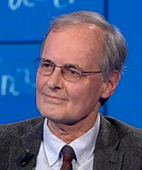He studied and worked in Pisa, the United States and Rome, and taught at the Universities of Pisa, Udine and Rome Tor Vergata, where since 1989 he is Professor of Numerical Analysis at the Department of Mathematics. His scientific contributions have appeared in leading international journals and are in the areas of numerical linear algebra, matrix theory, algorhithmic complexity and numerical optimization. He has also examined the impact of studies in these fields within the overall framework of the history of mathematics and, more generally, of the history of ideas.
With his scientific work he has shown, in particular, how a modern reinterpretation of the concept of the algorithm allows us to reinterpret the essential aspects of the scientific thought, philosophy and theology of ancient civilizations. He has delivered lectures in several Italian and foreign universities and institutions, as well as at national and international conferences. He has worked extensively with the Laboratory of Humanistic and Scientific Disciplines at the SISSA, Trieste. He won the Viareggio Prize for non-fiction (first work) in 1980 and the SEFIR prize in 2013. He has authored books translated into many languages and contributes to the culture pages of several national newspapers.
Main publications
1. P. Zellini, Breve storia dell’infinito, Adelphi, Milano, 1980; tr. in spagnolo: Breve Historia del Infinito, Siruela, Madrid, 1991; tr. in inglese: A Brief History of Infinity, Penguin, London, 2004; tr. in turco: Sonsuzun Kisa Tarihi, Dost, 2009; tr. in tedesco: Eine kurze Geschichte der Unendlichkeit, C.H.Beck, 2010.
2. P. Zellini, La ribellione del numero, Adelphi, Milano, 1985; tr. in spagnolo La Rebelión del Número, Sextopiso, Madrid, 2007.
3. P. Zellini, Gnomon, una indagine sul numero, Adelphi, Milano, 1999
3b. P. Zellini, Il logos della scienza, Monte Università Parma Editore, Parma, 2007.
4. P. Zellini, Numero e logos, Adelphi, Milano, 2010; tr. in spagnolo presso Quaderns Crema, S.A., Barcelona. (in corso di stampa)
5. D. Bertaccini, C. Di Fiore, P. Zellini, Complessità e iterazione. Percorsi, matrici e algoritmi veloci nel calcolo numerico, Bollati Boringhieri, Torino, 2013.
6. R. Bevilacqua, P. Zellini, Strutture e algoritmi veloci, Le Scienze, Quaderni, n. 84, 1995, pp.36-45.
7. P. Zellini, Leopardi, il pensiero matematico e il linguaggio dell’infinito, Lettere Italiane 4/1998, pp. 606-615.
8. P. Zellini, I pitagorici e il computer, in I. Dionigi (a cura di), Di fronte ai classici. A colloquio con i Greci e i Latini, Rizzoli, Milano, 2002.
9. P. Zellini, Postfazione a R. Guénon, I Princìpi del Calcolo Infinitesimale, Adelphi, Milano, 2011, pp.205-223.
10. P. Zellini, Numerici, Calcoli, voce della Enciclopedia Italiana, V Appendice (IT-O), pp. 699-704, 1993.
11. P. Zellini, Discreto e continuo e Ordinare il mondo, voci dell’Enciclopedia Italiana, XXI Secolo, Universo Fisico, pp. 111-119 e pp. 525-534, 2010.
12. P. Zellini, Effettività ed efficienza, in Paradigmi, Anno XXIX, Nuova Serie, Settembre-Dicembre 2011, pp. 73-87.
13. P. Zellini, Figure della ripetizione nella filosofia della natura di Giordano Bruno, pp. 103-128 in O.P. Faracovi (a cura di), Aspetti della Geometria nell’Opera di Giordano Bruno, Pubblicazioni del Centro Enriques, Livorno, Agorà & Co., Lugano, 2012.
15. P. Zellini, Logos und Zahl, pp. 171-191 in L. Perilli (Hrsg.), Logos, Theorie und Begriffsgeschichte, WBG (Wissenschaftliche Buchgesellschaft), Darmstadt, 2013.
16. P. Zellini, On the optimal computation of a set of symmetric and persymmetric bilinear forms, in Linear Algebra Appl. 23:101-119 (1979).
17. P. Zellini, On some properties of circulant matrices, in Linear Algebra Appl. 26:31-43 (1979).
18. P. Zellini, Algebraic and computational properties of a set of (0,1) matrices with prescribed sum, in Linear and Multilinear Algebra 17:355-373 (1985).
19. P. Zellini, Optimal bounds for solving tridiagonal systems with preconditioning, in SIAM J. Comput. 17:1036-1043 (1988).
20. R. Bevilacqua, P. Zellini, Closure, commutativity and minimal complexity of some spaces of matrices, in Linear and Multilinear Algebra 25:1-25 (1989).
21. R. Bevilacqua, P. Zellini, Structure of algebras of matrices and their complexity, in AAVV, Complexity of Structured Computational Problems (Applied Mathematics Monographs), CNR, Giardini Editori, Pisa, 1991, pp. 189-239.
22. C. Di Fiore, P. Zellini, Matrix decompositions using displacement rank and classes of commutative matrix algebras, in L, 229:49-99 (1995).
23. R. Bevilacqua, P. Zellini, Structure of algebras of commutative matrices, in Linear Algebra Appl. 233:5-41 (1996).
24. R. Bevilacqua, C. Di Fiore, P. Zellini, h-space structure in matrix displacement formulas, in Calcolo 33:11-35 (1996).
25. C. Di Fiore, P. Zellini, Matrix displacement decompositions and applications to Toeplitz linear sistems, in Linear Algebra Appl. 268:197-225 (1998).
26. C. Di Fiore, P. Zellini, Matrix algebras in optimal preconditioning, in Linear Algebra Appl., 335:1-54, (2001).
27. C. Di Fiore, S. Fanelli, F. Lepore, P. Zellini, Matrix Algebras in quasi-Newton methods for unconstrained minimization, in Numer. Math. 94:479-500 (2003).
28. C. Di Fiore, F. Lepore, P. Zellini, Hartkey-type algebras in displacement and optimization strategies, in Linear Algebra Appl. 366:215-232 (2003).
29. C. Di Fiore, S. Fanelli, P. Zellini, Low-complexity minimization algorithms, Numer, in Linear Algebra Appl. 12:755-768 (2005).
30. C. Di Fiore, S. Fanelli, P. Zellini, On the best least squares fit to a matrix and its applications, in Algebra and Algebraic Topology, ed. by Ched E. Stedman, Nova Science Publishers Inc., 2007, pp. 73-109.


